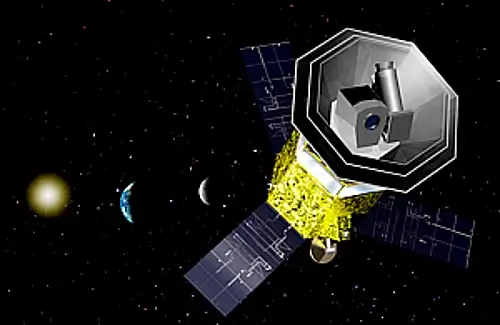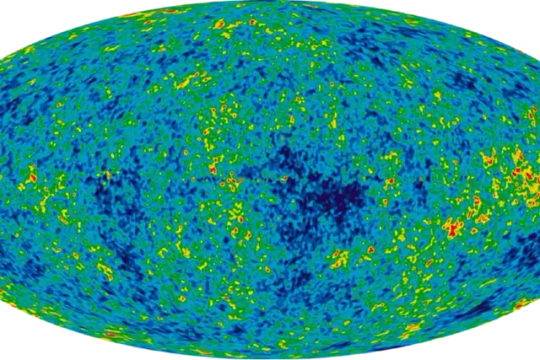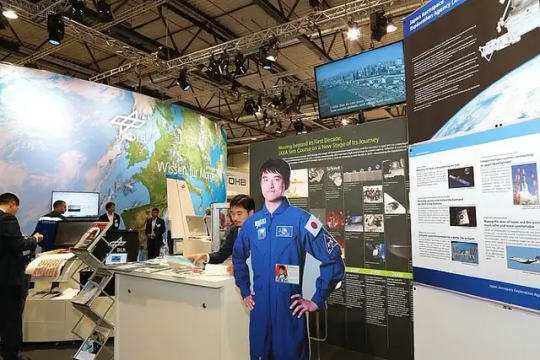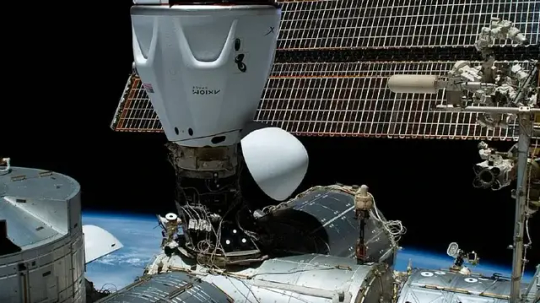#JAXAMarsRover
Explore tagged Tumblr posts
Text
LiteBIRD Mission Unveils Cosmic Secrets Worldwide

UK's Role in Cosmic Exploration
In a pivotal contribution to the quest for understanding the origins of the universe, the United Kingdom is set to play a crucial role in the pioneering LiteBIRD mission. Led by Japan, this ambitious mission aims to trace patterns in light from space, taking us on a journey back to the very birth of the cosmos, a monumental leap in our comprehension of the universe's beginnings. Probing the Big Bang The LiteBIRD mission, short for 'Light satellite for the study of B-mode polarization and Inflation from cosmic background Radiation Detection,' focuses on analyzing variations in the light that was left behind after the Big Bang. Its primary mission is to scrutinize the prevailing cosmological inflation theory, which describes the rapid expansion of the universe immediately following its creation.

A section of a detailed representation of the distribution of CMB radiation density. Photo by NASA - WMAP Science Team.
UK's Investment and Contributions
The UK Space Agency has committed an initial investment of £2.7 million to support the LiteBIRD mission. This financial backing will serve two primary purposes: UK Scientists at the Helm Firstly, it will enable a group of UK scientists to engage in designing critical components of LiteBIRD's specialized science instruments and analyzing their findings. Cardiff University's Unique Expertise Secondly, Cardiff University, renowned for its unique expertise, will produce the lenses and filters required for the telescopes. This distinct capability positions the university as the sole institution worldwide capable of creating these specialized components.
Future Commitments
The UK Space Agency's commitment doesn't stop here. It intends to inject a total of £17 million throughout the mission's lifespan, slated for launch before 2030. This reaffirms the UK's dedication to pushing the boundaries of space exploration and deepening its collaborations, particularly with Japan.
A Growing UK-Japan Partnership
The LiteBIRD mission is but one facet of the growing partnership between the UK and Japan in the field of space exploration. The commitment to this mission was unveiled during the International Astronautical Congress in Baku, Azerbaijan, where the UK pledged £1.7 million from its £20 million International Bilateral Fund to support Viasat's In-Range telemetry relay service, designed for Mitsubishi Heavy Industry's H3 launch vehicle, scheduled for liftoff in 2025. George Freeman MP, Minister for Space at the Department for Science, Innovation, and Technology, expressed his enthusiasm, stating, "This initial £2.7 million investment... is a great moment for both UK space science and technology and our deepening science, technology, and innovation collaboration with Japan."
A Game-Changing Mission
Dr. Paul Bate, Chief Executive of the UK Space Agency, anticipates that LiteBIRD will be a game-changer in the field of cosmology, enabling scientists to put prevailing theories about the universe's origins to the test. He described it as: "incredibly exciting for the UK to be at the forefront of this mission." Challenging Cosmological Inflation At the heart of LiteBIRD's mission is the challenge to the cosmological inflation theory. This theory postulates the existence of "primordial gravitational waves" observable within the cosmic microwave background (CMB), the lingering light from the early universe. LiteBIRD intends to examine the pattern of B-mode polarization in the CMB to either confirm or disprove this influential theory.

JAXA Exhibiting at the Berlin ExpoCenter Airport. Photo by DLR German Aerospace. Flickr.
A Multinational Endeavor
Coordinated by the Japanese Aerospace Exploration Agency (JAXA), the LiteBIRD mission is poised to deploy a combination of high-, mid-, and low-frequency telescopes. These advanced instruments aim to detect B-mode signals in the cosmic microwave background (CMB) with an unparalleled level of sensitivity. The UK's active involvement is seamlessly integrated into this collaborative effort. This partnership operates through a European Consortium, masterfully led by the French space agency CNES. Notably, CNES holds the responsibility for delivering the high and mid-frequency telescopes, further enhancing the mission's scientific capabilities. Leading Optical Development Cardiff University takes the lead in optical design and component development. Additionally, they receive support from other prominent UK universities, including Cambridge, Mullard Space Science Laboratory, University College London, Oxford, Manchester, and Sussex. Professors Peter Hargrave and Erminia Calabrese will spearhead the UK's contribution from Cardiff University. Their primary focus will be on designing and building optics for two telescopes and filters for the third, which is Japanese-built. The Search for Gravitational Waves Professor Hargrave, LiteBIRD UK Consortium Principal Investigator, shared his excitement, noting that LiteBIRD's mission will "confirm or rule out broad classes of inflation models, and greatly enhance our understanding of the origins of our Universe." Dr. Kuninaka Hitoshi, DG, Institute of Space and Astronautical Science (ISAS), Japan Aerospace Exploration Agency (JAXA), highlighted the international cooperation behind the mission and the invaluable contributions of the UK, including Cardiff University's unique technology.
Beyond LiteBIRD
In addition to its role in the LiteBIRD mission, the UK Space Agency is also supporting experts at the University of Aberdeen in designing an instrument for a future JAXA Mars rover. Named "Habit," this device will explore the habitability of the landing site, provide environmental information, and demonstrate In-Situ Resource Utilization technology for future Mars exploration.
Looking for Traces of Cosmological Inflation
The concept of cosmological inflation and its connection to LiteBIRD's mission is a fascinating area of study. The theory asserts that immediately after the Big Bang, the universe underwent exponential expansion, leaving traces observable in the cosmic microwave background (CMB) as "primordial gravitational waves." The Cosmic Microwave Background The CMB, composed of remnant light from the early universe when it was a hot plasma, appears largely uniform but contains subtle variations. These variations, corresponding to gravitational waves imprinted on B-mode polarization signals in the CMB, hold the potential to shed light on the universe's immediate post-Big Bang history.
UK Space Agency's Support and Engagement
The UK Space Agency's involvement in the LiteBIRD mission extends beyond financial support. It encompasses a group of UK scientists tasked with designing the mission's specialized telescope optical instruments. Moreover, Cardiff University's unique expertise comes into play as it manufactures the lenses and filters essential for LiteBIRD's telescopes. Collaboration in Action The mission operates within a European Consortium, led by France's CNES, with the UK taking a prominent role. Much of the optical design and component development are overseen by Cardiff University, with support from various UK institutions. Optics and Filters Cardiff University's team will design and construct optics for two telescopes and filters for the third, all of which are pivotal for LiteBIRD's success.

The SpaceX Dragon spacecraft is pictured docked to the space-facing port on the International Space Station. Photo by NASA.
Unveiling LiteBIRD's Mission
LiteBIRD, a mission led by the Japanese Aerospace Exploration Agency (JAXA), has a noble aim: to uncover compelling evidence that supports the cosmological inflation theory. Crafted and meticulously manufactured by the Institute of Space and Astronautical Science (ISAS) in Japan, this spacecraft will carry a weight of approximately 450 kg. Furthermore, it will be launched into the cosmos using the powerful H3 launch vehicle. Detecting B-Mode Signals LiteBIRD's primary objective is to detect B-mode signals within the CMB. This data will provide conclusive evidence regarding the nature of the universe's expansion in the moments following the Big Bang.
The Telescopes of LiteBIRD
LiteBIRD will execute a comprehensive three-year full-sky survey from the Sun-Earth Lagrangian point (L2). In order to achieve this ambitious goal, it will employ three telescopes. Moreover, each of these telescopes will cover a range of light frequencies: the Japanese-delivered Low-Frequency Telescope (LFT) and the European-delivered Medium-High Frequency Telescope (MHFT). Furthermore, these telescopes will utilize cutting-edge technology, including around 4,500 transition edge sensors spread across 15 observational frequency bands. Cutting-Edge Technology LiteBIRD's telescopes are equipped with state-of-the-art lenses and specialized frequency filters. Consequently, they will operate at a cryogenic temperature of around 100 mK to minimize thermal noise and employ superconducting polarimeters for exceptionally sensitive measurements of B-mode signals' polarization. In a groundbreaking cosmic exploration endeavor, the UK's involvement in the LiteBIRD mission signifies a significant leap forward in our understanding of the universe's birth and early evolution. Furthermore, as the mission sets its sights on the cosmic microwave background and the traces of cosmological inflation, the UK's scientific and technical contributions play a pivotal and indispensable role in advancing our knowledge of the cosmos. With a mission launch anticipated before 2030, the world eagerly awaits the revelations that LiteBIRD will bring to the forefront of cosmological research. Sources: THX News & UK Space Agency. Read the full article
#B-ModeSignals#CardiffUniversityOptics#CosmicMicrowaveBackground#CosmologicalInflationTheory#GravitationalWaves#InflationTheoryEvidence#JAXAMarsRover#LiteBIRDMission#UKSpaceAgency#Universe'sOrigins
0 notes